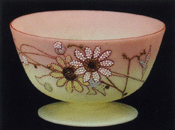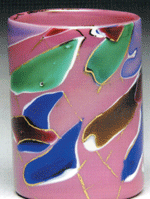|
Victorian Art Glass Developed Many New Techniques
By Anne Gilbert
Late 19th century American art glass borrowed some of its motifs from nature;
others, such as the filigree pieces, adapted Venetian styles. It was an exciting
time in glassmaking history that resulted in glass such as the world had never
seen before. The public couldn't get enough as hundreds of pieces from vases to
miniature lamps came to the market. The names were as novel and sometimes as
exotic as the color combination and techniques. There was "Crown Milano," made
by the Mt. Washington Glass Company. Though there was nothing new about
enameling and painting on opal glass, when it was named "Crown Milano, it became
instantly popular. When "Burmese" glass was introduced by the company, the
salmon pink and translucent yellow colors evoked visions of a Burma sunset.
Often, designs such as a fish swimming in a net of gold or a fern were used.
These days, pieces can sell at auction for from $2,000 to around $6,000.
Two
other popular Mt. Washington original techniques were shaded wares. "Peach Blow"
and "Amberina" are the best known. Strangely, they weren't popular in their day,
but they have become appreciated by today's' collectors. Amberina shaded amber
to rust. Considered choice are peach blow pears and peach in the shape of the
fruit.
In 1884, a patent for Vasa Murrhina Art glass was registered by John
Charles De Voy in Sandwich, Massachu-setts. It is one of the most colorful
examples of art glass and was named for "Vasa Murrhina," originally supposed to
have been made by the Boston Sandwich glass Company. It was either transparent
or cased with imbedded pieces of colored glass and mica flakes. These days, it
is modestly priced from around $180 to $600.
"Onyx" glass was made beginning
in 1889, adding a touch of elegance to the art glass market. Slightly
opalescent, it was decorated with pattern molded floral and leaf motifs that
were painted with a platinum luster. Prices range from around $300 to $1,600.
Imitating stone and marble in glass goes back to antiquity. However, it was
once again made by the Challinor, Taylor & Company of Pittsburgh,
Pennsylvania. "Moss Agate" stone glass was originated by John Northwood and made
by Stevens and Williams.
Historical events often led to creating a new type
of Art Glass. Such was the case when late 19th century archeological digs at
Troy, Mycenae, made discoveries of ancient glass and pottery. It was known as
"Sicilian Ware" when Mt. Washington Glass Company marketed it as "lava glass." A
lava tumbler sold at the summer James Julia Auction for well over estimate for
$6,038.
CLUES: While Victorian Art Glass went out of fashion with collectors
from the early 20th century to around 1960, it made a big comeback in the 1970s.
Unfortunately, many types were reproduced. When buying either, do your research
or get help from a knowledgeable dealer.

|

A Mt. Washington Burmese decorated sugar bowl. (Photo, courtesy James Julia
Auctions.)

An art glass Lava tumbler. |